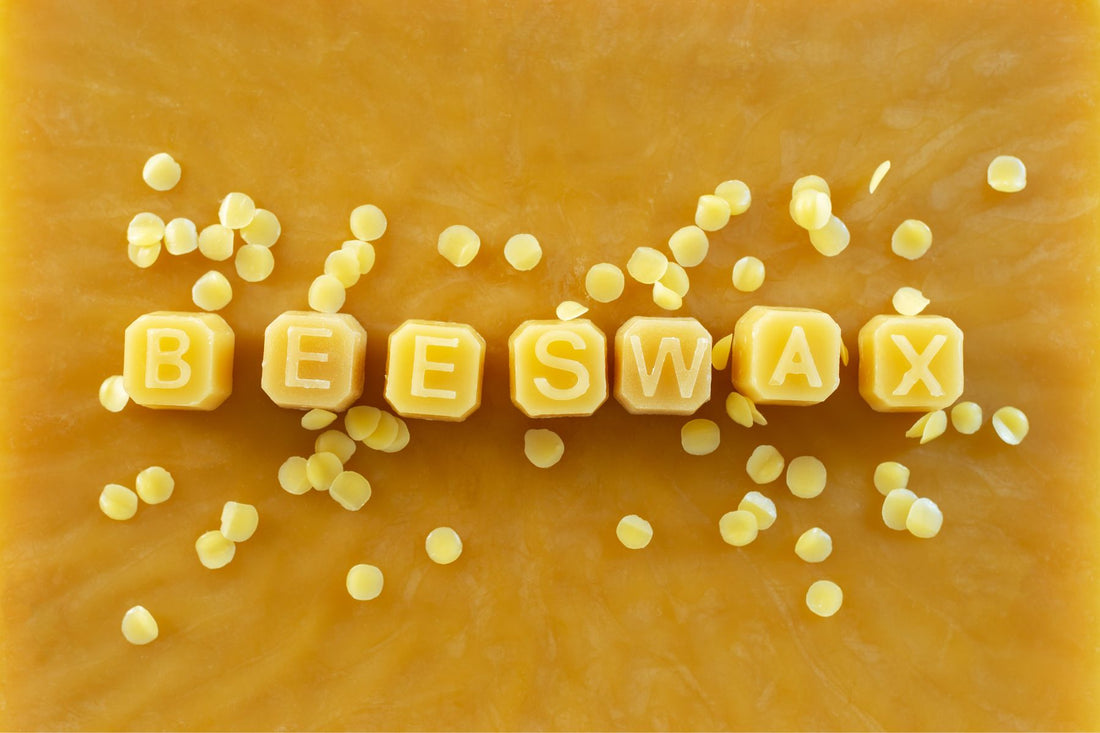You likely have beeswax in your house right now, without even knowing it. From lipstick to wood conditioner to cheese rinds, beeswax’s uses go well beyond candles.
Despite its ubiquity, beeswax and its properties aren’t that well-known. But, this high-potency substance deserves its moment in the spotlight — especially when it comes to skincare. Here’s why adding beeswax to your beauty routine may just be the best thing you do for your skin.
What is beeswax?
If you’re like most people, you likely haven’t given much thought to beeswax and where it comes from. But those sweet-smelling candles don’t just appear by themselves. Bees make this natural wax to form the intricate honeycomb structure inside their hive.
This comb doubles as both the nursery where bee larvae are nurtured, and later, as a storeroom for that golden superfood — honey.
How do bees make beeswax?
Bees are the original homesteaders — they either make or forage for everything they need. Their impressive self-sufficiency results in more than just honey. Bees make several additional substances with significant health benefits, and beeswax holds an important spot on that list.
The process of making beeswax is highly specialized. Worker bees develop four pairs of glands on their abdomen exclusively for the task. But their wax making days are numbered — only those in the first 12 to 20 days of their life are capable of doing it.
To make the wax, the young worker bees secrete a liquid from their abdominal glands. As it hits the air, the liquid solidifies, forming tiny scales. This allows the bees to detach the pieces of nascent wax and pass them forward for the next stage in the process — chewing.
As the bees chew the new wax with their mandibles, they inject pollen and some of their saliva into it, making it malleable. Once it’s achieved the proper consistency, the bees arrange the wax into a precise hexagonal honeycomb shape.
The process sounds simple but make no mistake — beeswax is an extremely energy-intensive undertaking for the bees. Each scale is only slightly wider than a crayon tip, and more than 1000 are needed to make a single gram of beeswax.
Further, it takes between 4 to 8 kg of honey just to produce 1 kg of wax, and each bee is only capable of producing about eight scales a day. Given the number of flowers a bee must visit to produce a single teaspoon of honey, making beeswax is also extremely time consuming. But, bees are clearly on to something because beeswax’s attributes are substantial.
How does beeswax help your skin?
When it comes to skincare, beeswax is liquid gold. Not only is it a natural product, which means it's free of irritating chemicals and synthetic fragrances, it’s also incredibly beneficial for your skin. Here’s what it can do:
How beeswax helps with skin’s hydration
Beeswax is a humectant, which is an exceptionally important class of ingredients in skincare. Humectants are hygroscopic substances which means they attract and bind water molecules, helping to nourish your skin by increasing its hydration. Dry skin sufferers out there are likely familiar with other skincare humectants like glycerin and hyaluronic acid.
Beeswax goes a step beyond these hydration-loving attributes, however. In addition to attracting water molecules, beeswax also functions as a barrier, locking moisture in so your skin stays hydrated, longer. If you’re worried that this barrier action means you’ll end up with blocked pores, don’t be. Beeswax is non-comedogenic, which means it won’t clog pores.
Together, beeswax’s natural humectant and barrier properties leave your skin soft, supple, and moisturized. This makes it a perfect ingredient for lip balms, moisturizers, and body butters where it can help to banish rough, chapped, and windburned skin.
How beeswax can help with acne
In addition to being non-comedogenic, studies show that beeswax inhibits microbial growth. Among others, this includes the bacteria E. coli, various forms of streptococcus bacteria, and the yeast Candida albicans.
These antimicrobial properties make it a boon for skin conditions like acne. Acne is fueled, at least partially, by bacteria that feed on sebum (oil). As a result, the vast majority of acne treatments are incredibly harsh and cause dry skin.
Beeswax, in contrast, provides antibacterial and antimicrobial benefits with none of the harshness of traditional acne medicines. And, this isn’t the only way it seems perfectly formulated for this skin condition.
Acne is an inflammatory disease, which means it’s due in part to an overzealous immune system response. Beeswax, luckily, comes with anti-inflammatory properties, making it perfectly suited to calming acne-prone skin.
Beeswax for wrinkles
Dermatologists affirm that retinol is about as close to a silver bullet as you can get when it comes to countering the effects of aging. Found in a number of skincare products marketed for mature skin, retinol is basically the holy grail of anti-aging. What’s less well-known is that it’s a derivative of vitamin A, which means it has many natural sources. One of these is beeswax.
Your body uses the protein collagen to make connective tissue, and it’s the marker of a youthful appearance. As you age, your collagen production decreases, which is where retinol comes in.
Vitamin A, or retinol, penetrates deeply into your skin, stimulating collagen production. Regular use results in plumper skin with fewer wrinkles and fine lines. It can also increase your skin’s elasticity and minimize the appearance of enlarged pores.
Since it also stimulates the production of blood vessels in your skin, retinol helps to banish uneven skin tone, and is great for treating hyperpigmentation or fading age spots. These same properties also make vitamin A-rich beeswax a powerhouse for fading scars and erasing stretch marks.
Topical retinol does have a major drawback which is that it’s often harsh on skin. This doesn’t apply to beeswax, however, as its soothing and hydrating properties neutralize any potential issues from its vitamin A content. This enables you to derive the anti-aging benefits of its retinol components with none of the irritation that often comes with synthetic forms of the ingredient.
Beeswax for eczema and psoriasis
Eczema, or atopic dermatitis, and psoriasis are chronic skin conditions rooted in inflammation and irritation. Both conditions can be quite uncomfortable, and symptoms often include dry, scaly patches of skin that may be red or itchy.
While there’s no cure for either, treatments do exist. These often centre around corticosteroids to reduce inflammation and moisturizers to, well, moisturize. Unsurprisingly, beeswax is also effective at treating these skin conditions.
Beeswax’s anti-inflammatory properties are perfect for soothing the redness and irritation often associated with eczema and psoriasis. And, its vitamin A content can address any skin texture issues that arise.
Moreover, beeswax’s ability to form a barrier helps to protect your skin from potential irritants like dust and mould. This is particularly helpful for eczema as environmental triggers often cause it to flare-up.
Interestingly, mixing beeswax with other natural substances may amplify its powers. A small study found that a mixture of beeswax, honey, and olive oil significantly improved symptoms in the majority of atopic dermatitis and psoriasis patients.
Are there any downsides to using beeswax skincare products?
Topical treatments for acne can be drying and irritating. And, while synthetic retinol can be a miracle for certain skin issues, it often causes redness, irritation, burning, itching, and dry skin. Beeswax, on the other hand, provides natural retinol, as well as a host of hydrating, and antimicrobial benefits, with none of the drawbacks.
The caveat to this is allergies. While you’re more likely to have an allergic reaction to topically applied beeswax if you have a preexisting bee sting allergy, that’s not always the case.
Even if you’ve been stung before without issue, it’s a good idea to patch test any new skincare products before use. Everyone’s skin is different, and although reactions to topical beeswax are rare, it’s better to be safe than sorry.
What else can you use beeswax for?
While beeswax has many skincare benefits, that’s not its only value. Beeswax’s anti-inflammatory properties appear to translate to chronic physical conditions as well. A promising study of arthritis sufferers, for example, found that a solution of beeswax alcohols — essentially a powdered crystalline material extracted from beeswax — reduced pain and stiffness levels by more than 50% and 75% respectively.
Food storage also owes a debt of gratitude to beeswax’s antibacterial abilities. Long before cling wrap or Tupperware containers, beeswax wraps were an efficient way of preserving food — and that continues to this day.
Not only do beeswax wraps extend freshness by limiting food’s air exposure, their natural antifungal and antibacterial beeswax coating also curtails spoilage by preventing mould and bacteria. Plus, they’re better for the environment than their plastic competitors.
Beeswax is even promising for more intractable health problems. Though it may seem weird, adding beeswax to your diet can help lower your cholesterol levels. Indeed, beeswax almost seems to hold magical properties. In truth, however, there are limitations to what it can do.
Do beeswax candles reduce air pollution and help asthma symptoms?

If you’ve looked into the topic of beeswax candles, you’ve likely heard about their ability to purify the air. This theory centres around the idea that beeswax candles emit negatively charged ions when they burn. Supposedly, these particles bind to positively charged ions in dust and other indoor air pollutants, causing them to fall from the air.
While this may sound plausible, finding scientific studies to back it up proves impossible. Minds are made to be changed though — so if you can find the research to buttress this claim, please feel free to send it along!
What is true when it comes to beeswax candles, however, is that they’re a healthier choice than paraffin wax, which is a derivative of petroleum. If you’re going to burn candles, the Asthma Society of Canada recommends using 100% pure beeswax candles.
Beeswax candles produce a cleaner burn than paraffin ones, which means less soot. They’re also free of chemicals and synthetic scents that can trigger asthma symptoms in susceptible individuals. Plus, they smell amazing.
The final word on beeswax
Beeswax is a natural health product with a long list of proven therapeutic properties. From hydrating, to soothing, to regenerating, there isn't a skin concern around that wouldn’t benefit from the addition of some beeswax.
So, the next time you’re looking for a product to treat your acne, dry skin, scarring, or whatever else, consider one that’s made with natural beeswax. Your skin will thank you.



